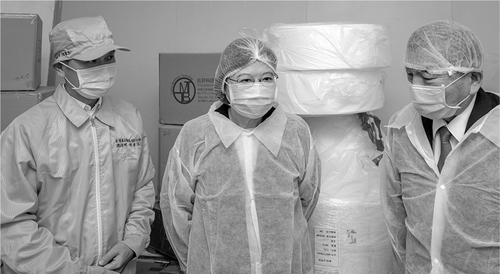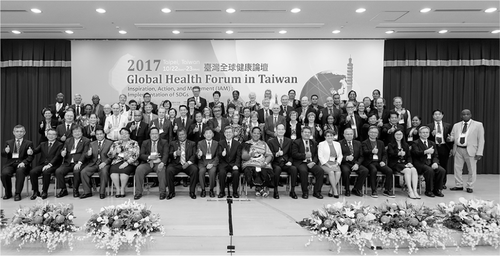How Taiwan’s Precautionary Approach Contained COVID-19

The COVID-19 pandemic vividly illustrates the global expansion of what German sociologist Ulrich Beck calls the “risk society.” As Beck argues in his 1992 book Risk Society, until WWII, we lived in a “first modernity” primarily concerned with the production of massive wealth and goods. With pollutants, ecological destruction, and nuclear and other accidents associated with producing such wealth and goods becoming regular components of life, we have entered into a “second modernity,” in which governments and ordinary citizens are increasingly burdened with the concern of how to manage these risks.
Indeed, with the coronavirus spreading far and fast through cruise ships, flights, stadiums, and other modern facilities that enable frequent travel and large gatherings, we are confronted with a sobering reminder of the permeation of the man-made risks in our time and, accordingly, compelled to reckon with our responses to these risks. Yet these responses have been less than reassuring so far, ranging from passivity and willful denials, to public anxieties and state failures, meanwhile leaving this pandemic seemingly unstoppable.
In this context, Taiwan’s success at containing COVID-19 has caught the attention of epidemiologists and journalists around the world. On June 30, 2020, STAT, a health newsletter co-produced by the Boston Globe, observed an astonishing contrast. Upon concluding the second quarter of the year, the U.S. had suffered more than 2.5 million COVID cases and 125,000 deaths; in contrast, Taiwan had 446 confirmed cases and seven deaths for a population of nearly 24 million. On a per capita basis, the U.S. had 1,200 times as many Covid-19 deaths as Taiwan. The contrast seems to be growing starker as time goes on: By late October, while the COVID death toll remained at seven in Taiwan, that number rose to roughly 235,000 in the U.S. Even countries that have fared better than the U.S. are seeking to glean lessons from Taiwan’s record at keeping the pandemic at bay, as is reported in the New York Times, the Washington Post, National Public Radio, ABC News, the New Statesman, the Telegraph, the Guardian, and Der Spiegel.
Taiwan’s experience exemplifies a “precautionary approach” for pandemic intervention. The precautionary principle was first developed by German legal scholars and lawmakers in the 1970s and 1980s and later adopted by the European Union. As Lujan and Todt explain in their 2012 Social Studies of Science article, this framework advocates for the adoption of precautionary measures when scientific evidence about an environmental or health hazard is uncertain but the potential harm is substantial. Almost a textbook example of the precautionary principle, the Taiwanese government responded to the first sign of the new coronavirus with a set of comprehensive measures. On January 20, 2020, more than two months before the WHO declared COVID-19 a pandemic, the Taiwan National Health Command Center (NHCC) activated its Central Epidemic Command Center (CECC), which designed and coordinated a containment plan with at least 124 action items, including measures for border control, case identification, contact-tracing, and quarantine requirements and other guidelines. As confirmed and suspected cases began to increase, a committed and high-performing medical force remained capable of accessing a robust national stockpile of personal protective equipment (PPE) and a comfortable number of isolation wards and negative pressure rooms. International commentators praised Taiwan’s political leadership for its precautionary approach, not infrequently comparing it to the governments in Germany, Denmark, or New Zealand while contrasting it against the American and British administrations. Inside Taiwan, with an approval rating of 73% in May 2020, public support for President Tsai has reached an all-time high. Her Minister of Health and Welfare and Digital Minister are currently the two most popular politicians in the nation.
It is important to note that the Taiwanese government’s precautionary approach is effective only to the extent that its civil society has been actively mobilized to follow government-issued COVID guidelines and regulations. As a young democracy, the Taiwanese civil society is highly contentious, with members of the congress often engaging in physical fights, activists frequently organizing social movements, and political polarization along the pro-independence versus pro-unification fault-line overshadowing most elections. Yet with the threat of an outbreak looming large, this contentious civil society temporarily came together to advocate for the government’s precautionary approach. The two major newspapers across the political divide unified in their call for citizens’ adherence to the government guidelines for precaution. The Taiwanese government eased most of its COVID restrictions in early June, after maintaining a record of zero domestically transmitted cases for 4 incubation periods (56 days). Up until then, most individuals diligently practiced mask-wearing and social-distancing in public spaces and complied with travel restrictions and, when applicable, self-quarantine requirements.
In short, in the story of Taiwan’s precautionary approach for pandemic intervention, the key protagonists include both an engaged public and proactive leadership. It is the state that has provided the authority, coordination, scientific expertise, and enormous resources needed for the containment efforts. No amount of mask-wearing or social distancing practiced by individual citizens can substitute for these government duties. At the same time, these COVID guidelines can only yield fruits through high levels of societal collaboration, with the public enduring many inconveniences to prevent a potential outbreak without it ever becoming a full-blown crisis.
Taiwan certainly has not declared victory over COVID-19, as the global pandemic is far from abating. However, its precautionary approach has helped the island avoid any city-wide lockdowns or large-scale business or school closures. Most Taiwanese are relieved that, for now, their precaution has paid off. How did Taiwan manage to implement this model of pandemic intervention? At least three factors appear to be crucial in shaping the governmental mechanisms and civil society discourses that facilitated Taiwan’s precautionary approach: (1) the historical legacy of the SARS crisis, (2) the international context of Taiwan’s isolation, and (3) the institutional infrastructure of its universal healthcare system.
During the 2003 SARS outbreak, the scenario in Taiwan was the polar opposite of what happened in 2020. At that time, the state’s responses were tragically delayed and fraught with government infighting, resulting in Taiwan suffering the third largest SARS outbreak in the world (after China and Hong Kong). In the aftermath of the SARS crisis, the civil society mobilized to criticize these state failures and demanded systemic reforms. Accordingly, the Taiwanese public health administration underwent a series of reforms in preparation for future outbreaks. The post-SARS reforms included: the establishment of the NHCC as the command center for epidemics, the increase of national stockpile of PPE, the building of isolation wards, and the expansion of virus labs, among other things. These institutional legacies directly provided the governmental mechanisms for facilitating swift and centralized responses 17 years later, when COVID-19 struck. The historical context in which these mechanisms came about—the SARS-related suffering caused by the state’s unpreparedness— further served as a reminder to the public health authority that it needed to act preemptively rather than taking its chances when faced with a potential outbreak.
After some delays, the Taiwanese civil society also turned to discussions of its own failures during the SARS epidemic, when many horded masks, lied about their symptoms, disregarded self-quarantine guidelines, or mobilized for NIMBY (not-in-my-backyard) protests to block SARS patients seeking medical care from entering their communities. In the early stages of the COVID-19 pandemic, reflections of past uncivil acts fostered a civil society discourse of community interdependence, which encouraged citizens to recognize government-issued COVID restrictions as their civic duties. Such civic duties, cautioned many journalists and commentators, must not be ignored in the name of individual choices when the nation is on the precipice of a public health crisis. While newspapers across the political divide continued to ridicule each other’s positions on a host of issues, they nonetheless agreed, possibly due to the shared SARS memory, that wearing masks, practicing social-distancing, and reporting symptoms were life-and-death matters for the community. Because this discourse of civic inter-dependence circulated in the media across the ideological spectrum, its underlying precautionary principle avoided much of the danger of over-politicization.
The civil society alliance in supporting the precautionary approach was also shaped by how Taiwanese responded to their nation’s international isolation. Due to China’s rising influence, Taiwan’s sovereignty is recognized by fewer than 20 countries, and its access to most international forums has been blocked. Many Taiwanese vividly remembered how Taiwan was left alone to fight the SARS epidemic, with its requests for access to samples and data being denied by the WHO. When asked about the situation by a Taiwanese journalist, a Chinese diplomat replied, “Who cares about you?” This comment still echoed loudly in Taiwan 17 years later, quoted more than a few times during the COVID-19 pandemic as Taiwanese grappled with the realization that the international community, once again, would leave them to fend for themselves should they face a serious outbreak. This sense of collective vulnerability quieted the ideological quarrels in most (though not all) civil society discussions about the precautionary measures for containing the coronavirus.

Last but not the least, the success of Taiwan’s precautionary approach depended on its long-term investment in public health infrastructure. In 1995, Taiwan established its single-payer healthcare system, the National Health Insurance (NHI), after some difficult political battles between the conservative Nationalist Party and the grassroots Democratic Progressive Party. The NHI eventually expanded healthcare coverage in Taiwan from 40 percent to over 99 percent and is today widely recognized by all stakeholders—regardless of party affiliations—as a cornerstone for the Taiwanese community. During the COVID-19 crisis, the NHI, under the command of the NHCC and in collaboration with the National Immigration Agency, supplemented the NHI’s centralized cloud-based patient records with patients’ travel history This comprehensive patient data system, updated in real time, is incredibly important for the containment efforts, as it facilitates the NHCC in tracing paths of infections and alerts all hospitals and clinics when visited by high-risk patients.
Alice Chen’s story, reported in a newsletter of the Center for Health Journalism at the USC Annenberg School, illustrates how governmental mechanisms, a civic culture of interdependence, and the NHI system work together in Taiwan’s COVID story. On March 6, Alice’s study abroad program instructed her to leave Italy and return to Taiwan within three days. Upon deplaning in Taipei, Alice was greeted by a nurse who handed her a mask, interviewed by border control agents, and, after she mentioned a recent fever, directly escorted to an ambulance. Alice remained quarantined at the hospital for three days, where she was tested for COVID-19 twice, both of which came back negative. At discharge, Alice received instructions for how to fulfill the rest of her 14-day quarantine at home. As a real testimony to the NHI’s efficiency, Alice’s bill for her hospital stay and COVID-19 tests amounted to about $3.30 U.S. dollars. After Alice went home, a government staff person dropped by with a care package containing masks, a thermometer, disinfectant spray, and a variety of Taiwanese snacks. Someone from the city government called every morning to check in on her. During the pandemic, those who deviate from the quarantine orders can face a hefty fine, but the government also offers free WIFI, counseling services, and a daily compensation fee of roughly $33 U.S. dollars to those under quarantine. Yet for Alice, the key motivation for compliance was that “I just want to do my part, and not put anyone at risk.” While Alice might be too young to remember much about SARS, she shared that “there is a sentiment in Taiwan that we have to all cooperate and take these measures to protect…our community as a whole.”
Moving forward, Taiwan faces its share of challenges. As its public realizes that some form of medical rationing is inevitable in all universal healthcare systems, it must wrestle with the question of how most reasonably to delineate the boundaries of its healthcare membership. In March, a Congressman proposed to make it more difficult for overseas Taiwanese to utilize Taiwan’s health care system. An online survey ensued in the United Daily, with more than 80 percent of the respondents supporting the Congressman’s proposal or similar measures. Many commented that these measures would be necessary to ensure the NHI’s sustainability. While such discussions are necessary for maintaining the public mandate for the NHI, they also have the tendency to spiral into exercises of defaming the excluded. The Congressman and his supporters nicknamed his proposal “Huang An Proposition,” named after an infamous retired Taiwanese singer who resides in China and often belittles Taiwan but regularly returns to Taiwan for his medical procedures. The implication that overseas Taiwanese are disloyal to Taiwan while abusing the island’s resources is of course problematic and unproductive. To the extent that even inclusive communities cannot do without boundaries, Taiwanese must resist the temptation to belittle those who are located outside of their community, and instead treat even “outsiders” with respect and compassion.
Furthermore, a fundamental issue with the NHI’s sustainability is that it is chronically under-funded—Taiwan spends 6.5 percent of its GDP on healthcare expenditures — about two thirds of the healthcare expenditures in most developed countries and one third of that in the U.S. Fearing impacts on election outcomes, Taiwanese politicians have been avoiding the unpopular topic of raising the premiums. COVID-19 is introducing an opportunity for the public to confront this issue. However, having superficially scratched that itch with its brief, populist discussion about the “Huang An Proposition,” the Taiwanese public has once again dropped any serious discussion of raising the NHI premiums.
Without glossing over these challenges, what can we learn from Taiwan’s COVID response? One general lesson is that authoritarianism is not a necessary condition of successful pandemic mitigation. As my coauthor and I explain in a forthcoming article in the American Journal of Cultural Sociology, the Taiwanese case addresses the worry that “authoritarianism is more effective but less desirable,” precisely by demonstrating that well-functioning civil society can consolidate institutional mechanisms and societal preparedness for effective pandemic intervention. Compared to the alleged “authoritarian advantage” of crisis responses, the bottom-up mobilizations in civil society demand greater accountability from the state and nurture a greater self-awareness of civic interdependence among citizens. Taiwan—along with cases such as South Korea and Denmark—demonstrate that the dichotomy between pandemic control and individual freedoms is a false one.

Furthermore, the Taiwanese experience suggests that, in the U.S., the pendulum has swung too far on the debates about the precautionary principle. Many critics have argued that precautionary measures are too costly, as they tend to slow down economic activities and increase government spending. What has gotten lost in these arguments is that, when thoughtfully interpreted and implemented, and especially when the stake is high, precautionary measures are sometimes the best approach for saving lives and preventing catastrophes. This is not just about electing a thoughtful leader next time, although that is vitally important. In addition, before the next pandemic hits (and it will), we desperately need to have in place much more robust public health infrastructure and a much stronger civic culture that honors mutual protection as much as individual freedom. Taiwan had gone through a bumpy journey to build its universal healthcare system, strengthen its public health administration, and reckon with its collective vulnerability and civic inter-dependence, before the nation was poised to effectively design and implement a precautionary approach with COVID-19. Now, with our soaring numbers of COVID deaths and confirmed cases in the U.S., the American public must foster the political will and social reflexivity to collectively reconsider the principles of precaution and engage in necessary institutional and cultural changes.
